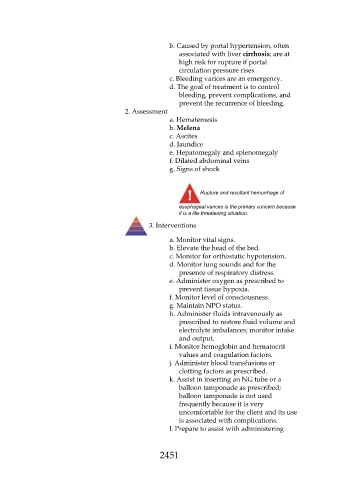Page 2451 - Saunders Comprehensive Review For NCLEX-RN
P. 2451
b. Caused by portal hypertension, often
associated with liver cirrhosis; are at
high risk for rupture if portal
circulation pressure rises
c. Bleeding varices are an emergency.
d. The goal of treatment is to control
bleeding, prevent complications, and
prevent the recurrence of bleeding.
2. Assessment
a. Hematemesis
b. Melena
c. Ascites
d. Jaundice
e. Hepatomegaly and splenomegaly
f. Dilated abdominal veins
g. Signs of shock
Rupture and resultant hemorrhage of
esophageal varices is the primary concern because
it is a life-threatening situation.
3. Interventions
a. Monitor vital signs.
b. Elevate the head of the bed.
c. Monitor for orthostatic hypotension.
d. Monitor lung sounds and for the
presence of respiratory distress.
e. Administer oxygen as prescribed to
prevent tissue hypoxia.
f. Monitor level of consciousness.
g. Maintain NPO status.
h. Administer fluids intravenously as
prescribed to restore fluid volume and
electrolyte imbalances; monitor intake
and output.
i. Monitor hemoglobin and hematocrit
values and coagulation factors.
j. Administer blood transfusions or
clotting factors as prescribed.
k. Assist in inserting an NG tube or a
balloon tamponade as prescribed;
balloon tamponade is not used
frequently because it is very
uncomfortable for the client and its use
is associated with complications.
l. Prepare to assist with administering
2451

